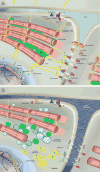Desmin related disease: a matter of cell survival failure
- PMID: 25680090
- PMCID: PMC4365784
- DOI: 10.1016/j.ceb.2015.01.004
Desmin related disease: a matter of cell survival failure
Abstract
Maintenance of the highly organized striated muscle tissue requires a cell-wide dynamic network that through interactions with all vital cell structures, provides an effective mechanochemical integrator of morphology and function, absolutely necessary for intra-cellular and intercellular coordination of all muscle functions. A good candidate for such a system is the desmin intermediate filament cytoskeletal network. Human desmin mutations and post-translational modifications cause disturbance of this network, thus leading to loss of function of both desmin and its binding partners, as well as potential toxic effects of the formed aggregates. Both loss of normal function and gain of toxic function are linked to mitochondrial defects, cardiomyocyte death, muscle degeneration and development of skeletal myopathy and cardiomyopathy.
Copyright © 2015 Elsevier Ltd. All rights reserved.
Figures



References
-
- Ho CY, et al. Lamin A/C and emerin regulate MKL1-SRF activity by modulating actin dynamics. Nature. 2013;497(7450):507–11. This paper describes for the first time the involvement of the nuclear intermediate filament proteins, lamins, in the modulation of the mechanochemical transcription factor MKL1. - PMC - PubMed
-
- Swift J, et al. Nuclear lamin-A scales with tissue stiffness and enhances matrix-directed differentiation. Science. 2013;341(6149):1240104. The importance of nuclear lamins in a systematic relationship between tissue mechanics, retinoic acid nuclear entry and stem cell differentiation was described for the first time. - PMC - PubMed
-
- Capetanaki Y, et al. Muscle intermediate filaments and their links to membranes and membranous organelles. Exp Cell Res. 2007;313(10):2063–76. - PubMed
-
- Capetanaki Y. Desmin cytoskeleton: a potential regulator of muscle mitochondrial behavior and function. Trends Cardiovasc Med. 2002;12(8):339–48. - PubMed
Publication types
MeSH terms
Substances
Grants and funding
LinkOut - more resources
Full Text Sources
Other Literature Sources
Medical

